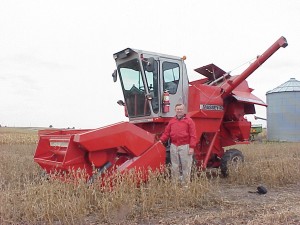A variety of plot and commercial-size equipment is used to assure uniformity and accuracy based on your specified protocol. The studies are designed for your needs whether marketing or to answer research questions. Tests may be in RCBD (randomized complete block designs) or others like Latin Squares that would be acceptable to scientific research criteria. Care is taken to randomize the treatments and provide adequate controls for the comparisons that are envisioned. Often the protocols are designed by the client, but will be reviewed and questions asked if something was overlooked. Plot sizes are typically 15 ft (6 rows at 30-inch spacings) by 30 ft or roughly 5 m x 10 m with the center two rows of corn or thee rows of soybeans harvested and usually four rows are sprayed or treated with in-furrow starters and the border rows act for a buffer and for comparison of visual treatment effects. In weed studies this provides an area where weed pressures are noted close to each treatment.
Irrigation
 Irrigation from a well and through a buried system provides for assurance of test results. The farm research area had new drainage tile installed on 40-ft centers in 2012, and in 2013 a pivot irrigation system was added to part of the farm. A traveling gun is available for smaller areas. In 2014 the submersible pump system was upgraded and a main waterway reshaped. Areas with good weed pressures are provided for good herbicide, adjuvant, and nozzle type-application-rate type tests. Conventional or no-till planting is available with a no-till 7100 John Deere mounted planter with starter lines to the center four rows.
Irrigation from a well and through a buried system provides for assurance of test results. The farm research area had new drainage tile installed on 40-ft centers in 2012, and in 2013 a pivot irrigation system was added to part of the farm. A traveling gun is available for smaller areas. In 2014 the submersible pump system was upgraded and a main waterway reshaped. Areas with good weed pressures are provided for good herbicide, adjuvant, and nozzle type-application-rate type tests. Conventional or no-till planting is available with a no-till 7100 John Deere mounted planter with starter lines to the center four rows.
Harvesting

Harvesting of plots is done with a MF 8 plot combine with electronic weighing and moisture testing systems where weights are taken to the nearest 0.1 pound and the moisture to the nearest 0.01 percent based on calibrated electronic readings. The system is a Juniper computed-based electronic data recording unit that automates the hopper system and records the data when the operator decides no more material is coming through the system. Recording is done on a removable computer unit that allows one to take the data to the computer where it is dumped into excel files for calculations of yield adjusted for grain moisture and plot length. Each plot is measured at harvest and the corn plants in the center two rows are counted near harvest for plant populations. In the field layouts the alleys are planted with the same crop in a perpendicular fashion so alleys can be harvested first with a large combine and this provides for a solid-field effect. Usually a corn-soybean rotation is used for crop sequences, but corn after corn can be used for special needs. The plot combine operator takes notes on field maps to assure data will not be lost if any electronic problem happens along the way and in addition notes any lodging or unusual plot differences including weeds in plots. A paper tape printer system is another backup provided with data collection. The Juniper measuring system was upgraded in 2013 along with the software needs. Field tests are at the ACRES station or at off-site areas that are suitable to crops including corn, soybeans, wheat, canola, turfgrass, field peas, or alfalfa.

